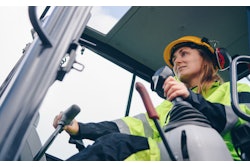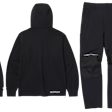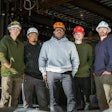
The U.S. Bureau of Labor Statistics indicates that nearly 11 percent of the construction workforce is female. Yet studies show the construction industry is still behind in providing safe and comfortable apparel for women workers.
Case in point: the safety vest, designed as a measure of protection to help workers stand out during daytime, nighttime, and other low-light conditions.
Road work has inherent potential dangers: the U.S. Centers for Disease Control indicates occupational struck-by incidents caused 150 deaths and 14,000 nonfatal construction sector injuries in 2020, totaling $1.4 billion in workers compensation direct costs for non-fatal claims with more than five days away from work.
A recent study, ‘Fitting In: Analyzing the Fit of Safety Vests in the Construction Industry’ by Lizette Galvez Puentes at California Polytechnic State University in San Luis Obispo, California highlights the concerns about the sizing of safety vests and calls upon the construction industry to “accommodate the changing gender demographics”.
While confidence and comfort were among the stated concerns, safety – specifically that women wearing ill-fitting vests set them up for getting caught on jobsite materials – is a paramount concern.
“A great concern was for the placement of pockets which should be designed for items regularly used in the industry now such as iPad, cell phones, tape measure, flashlight,” the study concludes, adding “pockets should take into consideration items that are fundamental to other genders that include products such as tampons and sanitary napkins.”
The study also acknowledged a lack of maternity safety vests, forcing workers to “size up to a ridiculous size that doesn't fit anywhere else but the baby bump,” instead of providing adjustment options such as waist cinching for their current vests.
Design Factors
Many manufacturers of construction apparel are recognizing the needs of women construction workers and are making safety clothing to fit women for both safety and comfort.
Women workers should only source apparel made for them as they do not derive the same level of protection when wearing hi-visibility vests made for men. There are several key differentiating factors affecting safety and comfort.
A woman’s high-visibility vest provides more room in the chest area. As women’s shoulders tend to be more narrow, the broader shoulders on a man’s safety vest makes it ill-fitting for a woman. The shape and location of arm holes also is a differentiating factor between men and women’s safety vests.
Also, with women’s hips having more curvature than men’s hips, a properly-designed women’s high-visibility vest sits correctly on the hips. Women’s vests with buttons and zippers are on the left-hand side. While this is an outdated apparel tradition rooted in the past when women were dressed by their servants, who were typically right-handed, it now serves as a telling factor as to whether a garment was designed for a woman or man.
Safety Standards for Safety Vests
After ensuring a high-visibility vest is made to fit a woman, those purchasing safety vests for women construction workers should heed the same safety considerations as their male counterparts. Vests should meet The American National Standards Institute (ANSI) guidelines, ANSI/ISEA 107-2020 standards for the design and production of hi-vis safety vests for maximum visibility and protection.
Typical high-visibility colors and their combinations include fluorescent yellow-green, fluorescent orange-red and fluorescent red. The best choice achieves the highest degree of worker contrast to the environment.
Type O high-visibility vests are for Class 1 off-road work. Type R high-visibility safety vests are for roadway work and includes Class 2 and Class 3:
- ANSI Class 2 is used to stand out against a background of many colors and depth, such as found in road construction.
- ANSI Class 3 is used when jobs necessitate high visibility, mobility, and flexibility, such as working in high-speed traffic and high-risk environments.
The hi-vis safety vest should incorporate appropriate separation distances of vertical and horizontal bands placed on the torso and appropriate retroreflective band placement and garment design.
Fire resistant high-visibility safety vests must meet ANSI standards as well as that of either the National Fire Protection Association or the American Society for Testing and Materials. They provide high visibility while providing protection from flames and arc flash, such as those working with equipment that can shoot out sparks or intense heat and start fires.
Find construction gear and workwear for women on IRONPROS! Start by browsing and comparing women's boots for your next project.















